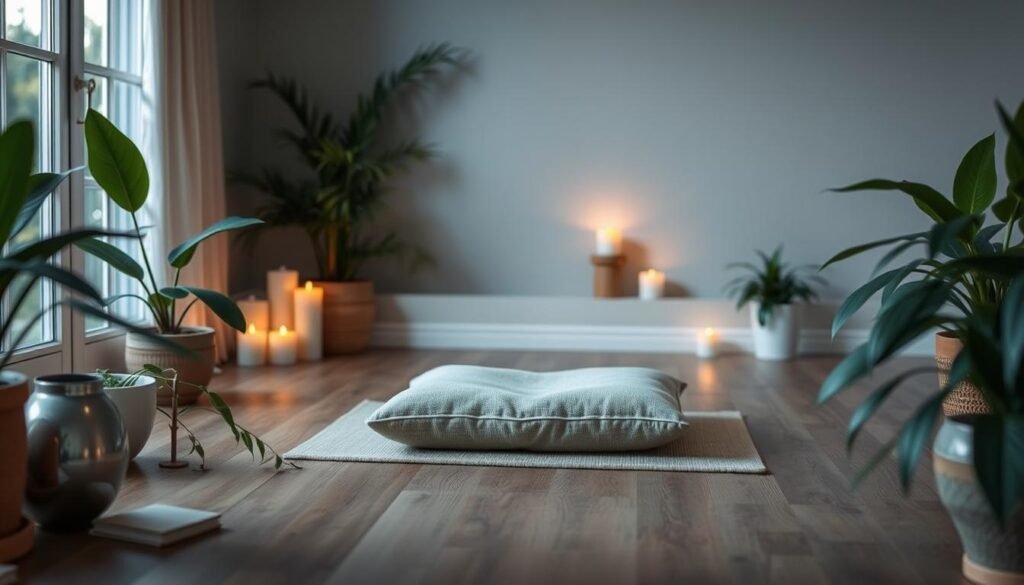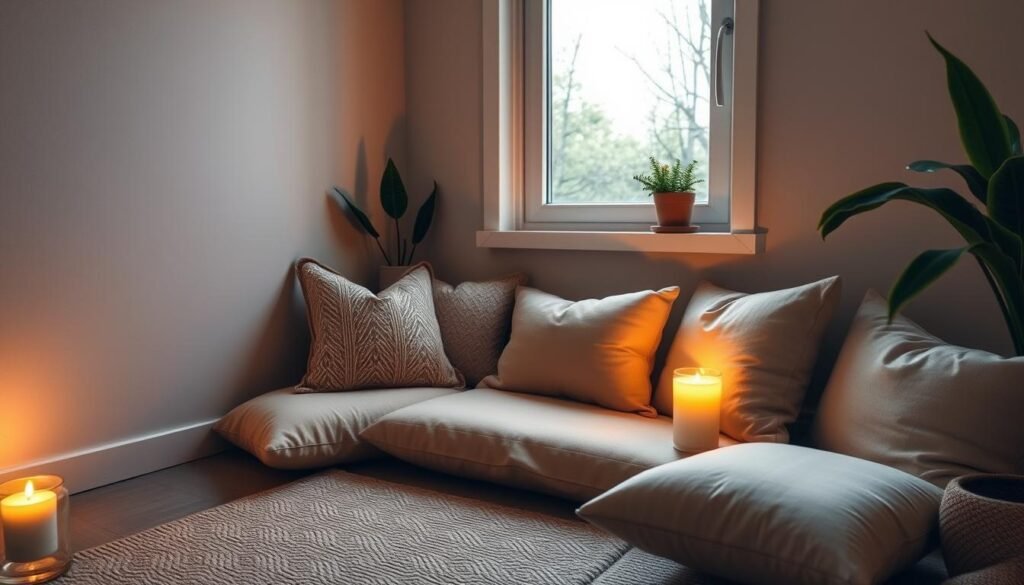Did you know daily meditation can lower stress hormone levels by up to 78%? Anxiety is a big issue today, and many people look for ways to cope. Guided meditation is becoming a favorite choice. It makes us mindful and calms our minds. Studies show anxiety relief through guided meditation works well. This guide will show how to begin using guided meditation for anxiety. You’ll learn about different techniques that turn anxious thoughts into a more serene mental state.
Research shows practices like SKY Breath Meditation really help. They improve overall well-being, stress, and mental health. We’ll cover various techniques designed to bring emotional balance and peace.
Key Takeaways
- Guided meditation is a strong way to fight anxiety.
- Doing it daily brings quick and lasting good effects.
- Sri Sri Ravi Shankar’s sessions specifically address anxiety problems.
- Regular meditation boosts emotional and physical well-being.
- Using breathwork is essential to start relaxation in meditation.
Understanding Anxiety and Its Impact
Anxiety is a feeling of nervousness, usually about what might happen. It can grow into anxiety disorders, affecting our lives deeply. The impact ranges from mental health issues to problems in relationships and work.
Studies have found a link between anxiety and stress. Stress makes anxiety worse, and not treating anxiety increases stress. Despite the high number of adults with anxiety disorders in the U.S., many don’t get help. This shows the need for better anxiety management.
Mindfulness and guided meditation are good for handling stress and anxiety. Techniques like Mindfulness-Based Stress Reduction have helped many with anxiety. People who meditate regularly often feel better in just weeks.
Knowing how serious anxiety is can push us to find ways to cope. Adding practices like meditation to our daily life is key. Embracing these methods starts us on a journey to better handle stress and anxiety.
What is Guided Meditation?
Guided meditation is a dynamic approach within the mindfulness and mental health sphere. It involves an instructor or a recorded voice, guiding people through meditation techniques aimed at reducing anxiety. They pay close attention to their thoughts in a systematic way. This matches with the essence of mindfulness, which focuses on being aware in the current moment on purpose.
It’s easy for people from all backgrounds to start guided meditation. A simple guide can help beginners get into the habit smoothly. Because of its flexibility, different people can incorporate it into their routines. Most practice lasts from five to 30 minutes, perfect for mornings or before sleep.
Guided meditation offers more than just a moment of calm. Studies show it can decrease anxiety, boost emotional health, and improve sleep. While apps like Calm and Headspace are popular, finding what works best might require some experimenting. Exploring various methods, including online and yoga studio sessions, enhances the experience. To learn more about relieving anxiety through guided meditation, click here.
Benefits of Guided Meditation for Anxiety Relief
Guided meditation offers numerous benefits for easing anxiety. It significantly enhances one’s ability to manage emotions. Focusing on the present moment helps people better respond to stress. Studies show that mindfulness meditation greatly reduces anxiety. A large study with nearly 1,500 college students showed big improvements in their anxiety levels after practicing mindfulness.
Guided meditation can also positively affect the body. It has been found to lower stress markers in people with generalized anxiety disorder. This combination supports both mental and physical health, leading to improved well-being overall.
Breathing techniques in guided meditation sessions help reduce stress and anxiety even more. The soothing music and sounds played during these sessions create a calming environment. This helps lessen anxiety symptoms. Guided meditation also helps individuals recognize their anxious feelings. They learn to react calmly rather than impulsively, changing how they deal with anxiety for the better.
- Reduced impulse control issues: Participants learn to respond thoughtfully to anxious thoughts.
- Enhanced focus on the present: Mindfulness brings attention to what is happening now.
- Greater resilience: Regular meditation practice helps maintain a balanced response to stressors.
Over 200 studies have shown that mindfulness-based therapies are effective in reducing stress, anxiety, and depression. Regularly attending guided meditation sessions can provide lasting mental health benefits. It helps individuals face life’s challenges with a sense of internal peace.
How to Start Guided Meditation for Anxiety
Starting meditation for anxiety might seem hard, but it’s simpler with the right steps. Knowing how to begin makes it less daunting and more fun.
Choosing the Right Environment
For effective meditation, a calm environment is essential. Find a quiet place where you won’t be disturbed. Make sure you’re comfortable by using cushions or blankets. This area should be welcoming and calm, helping you start your meditation journey.
Setting Your Intentions
Setting clear intentions before you begin is helpful. This boosts focus and commitment. Having a goal or affirmation for each session helps during hard times, keeping you on track.
Finding a Suitable Guided Meditation
There are many resources to find meditations for anxiety. Apps and websites like The Calm Place are often recommended by therapists. Trying out different types can help you find what works best, making it easier to begin.

| Aspect | Importance | Recommendation |
|---|---|---|
| Environment | Reduces distractions | Quiet, comfortable space |
| Intention Setting | Enhances focus | Clear personal goals |
| Guided Meditation | Effective for anxiety relief | Explore diverse styles |
Basic Techniques for Guided Meditation
Several methods stand out in guided meditation, each helping with anxiety relief. These techniques help calm the mind and boost well-being. Here are some effective ways to start.
Deep Breathing Exercises
Deep breathing is key in meditation. The 4-7-8 method helps with relaxation. You inhale for four seconds, hold for seven, and exhale for eight. Doing this regularly lowers anxiety and improves meditation.
Body Scan Meditation
Body scan meditation focuses on each body part without judging. It helps notice and release tension. Spending about 20 minutes on this can increase awareness of physical states and stress management.
Loving-Kindness Meditation
Loving-Kindness Meditation, or Metta, builds compassion. It involves affirmations for self-acceptance and goodwill towards others. It’s great for handling social anxiety and feeling connected with oneself and others.
For tips on meditation, including other techniques, check out these resources: Explore more techniques.
Best Practices for Guided Meditation Sessions
Effective guided meditation blends skill and understanding. To enhance the experience for guides and participants, follow these essential tips. They help master the calming technique of meditation.
- Use a calm, relaxed, and authentic voice.
- Speak at a slower than normal pace to promote relaxation.
- Time sessions with a stopwatch to maintain structure.
- Be comfortable allowing sessions to run long if needed.
- Take frequent pauses, letting participants absorb the experience.
- Meditate while guiding the meditation for a unified experience.
- Utilize a script to stay organized and focused.
- Practice frequently to build confidence and competence.
- Record practice sessions and guided meditations for self-assessment.
- Mediate to recordings to understand pacing and tone.
- Learn to chant or use sound in sessions for added depth.
- Keep water handy to stay hydrated during longer sessions.
Consistency in practice is key for improvement. As you practice more, your skills in timing, voice modulation, and mindfulness improve. Supportive friends can offer encouragement and constructive feedback, making your guided meditation better.
These tips create a supportive environment. They help build strong connections and bring about deeper relaxation for everyone involved.

| Tip | Benefit |
|---|---|
| Calm, relaxed voice | Creates a soothing atmosphere |
| Slower speaking pace | Enhances participant relaxation |
| Time sessions | Ensures structure and flow |
| Comfort with longer sessions | Allows deeper exploration |
| Frequent pauses | Encourages reflection and awareness |
| Meditate while guiding | Creates a shared experience |
Common Guided Meditation Techniques for Anxiety
Guided meditation offers different ways to help with anxiety. Each method is designed to help people relax and feel calm. These techniques are great for dealing with anxiety symptoms. Let’s look at some of the most helpful ones.
Guided Imagery for Anxiety Relief
Guided imagery uses visualization to create relaxation. People are asked to picture calming places, like a quiet beach or a peaceful forest. This helps shift focus away from worrying thoughts towards a calming space. Studies prove that guided imagery can quickly ease stress and lower anxiety. By imagining these peaceful scenes, people can feel much less anxious.
Mindfulness Meditation for Anxiety
Mindfulness meditation teaches us to live in the moment without judging our thoughts or feelings. It’s especially good for anxiety because it stops that loop of overthinking about the past or future. Research shows it can help reduce anxiety to a noticeable degree. Even 10 minutes of mindfulness can improve focus and performance, which is great for those struggling with anxiety.
| Technique | Goals | Benefits |
|---|---|---|
| Guided Imagery | Promote relaxation through visualization | Reduces anxiety symptoms; enhances calmness |
| Mindfulness Meditation | Focus on the present moment | Reduces ruminative thoughts; improves focus |
These guided meditation methods are effective for controlling anxiety. Both guided imagery and mindfulness meditation help people find peace and comfort. Using these techniques can greatly ease anxiety levels.
How to Maintain a Consistent Meditation Practice
Meditation can greatly help with anxiety management. It’s crucial to have a structured approach for lasting benefits. Making it a daily essential is necessary.
Establishing a Routine
Starting a meditation routine helps with long-term commitment. Beginning with just five minutes a day makes a difference. This time can slowly increase as you feel more comfortable.
It often takes 66 days to form a habit, showing the need for persistence. As beginners find their feet, extending sessions to 10 or 15 minutes is recommended. Striving for 30 minutes is a good long-term aim.
Habit tracking tools prove useful in this journey. They offer encouragement and show personal growth. Apps like Insight Timer, Headspace, or Calm are great for guidance and support.
Creating a Meditation Space
A special space for meditation can improve your practice. A peaceful setting helps in keeping up with regular meditation. Choose a comfy spot, like the floor with a pillow or an upright chair. The key is to be relaxed yet dignified.
Add personal touches like soft lighting or motivational quotes to inspire regular practice. Viewing meditation as a moment of presence is vital for daily life.

Combining Guided Meditation with Other Anxiety Treatments
Using guided meditation with other anxiety management methods greatly improves treatment. People find that meditation plus therapy and medication offers more relief options. Studies show that mindfulness practices like stress reduction can lessen anxiety symptoms.
Meditation helps relax and lower stress, making it easier to handle anxiety. It brings inner peace and boosts confidence in social situations. It also improves emotional control and increases self-awareness, helping understand social anxiety triggers.
Guided meditation can decrease heart rate, blood pressure, and muscle tension. While helpful, it’s often not enough by itself. It works best with cognitive therapy and other proven treatments.
Regular guided meditation sessions have reduced anxiety for many. They benefit from focusing on the present, which helps with anxiety. This method helps observe thoughts and feelings, improving day-to-day anxiety management.
Adding guided meditation to a treatment plan aids in managing anxiety. It also supports long-term mental health and self-kindness. To learn more, check out research on mindfulness-based interventions.
Conclusion
Guided meditation serves as a strong tool for anxiety management. It effectively lowers stress and mood-related symptoms. With millions facing anxiety in the U.S., meditation offers much-needed relief.
When it comes to easing anxiety, being regular and patient is key. Positive effects are often felt in just a week. Just a few minutes a day can make a difference. Daily practice brings benefits like better memory and less tiredness, proving meditation’s deep impact on our minds.
Trying out guided meditation can be a step towards understanding oneself better. It doesn’t matter if you eventually meditate on your own or with help; the peace it brings is profound. For those struggling with anxiety, incorporating meditation could be a game-changer for their mental health.